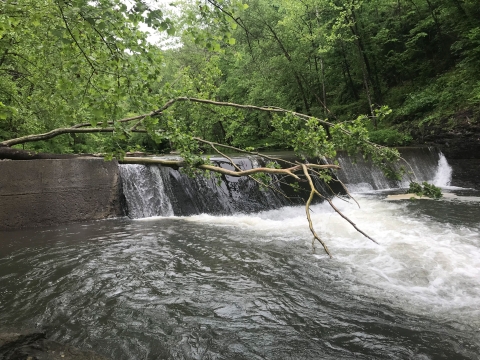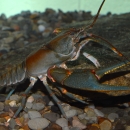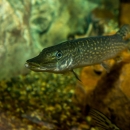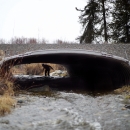This project will remove one hazardous low-head dam on the McClure River in the Town of Clinchco, Virginia, to benefit the federally threatened Big Sandy crayfish within Critical Habitat. Removal of this dam will fully reconnect the 22-mile McClure River for Big Sandy crayfish, allowing movement between two currently isolated and genetically important populations separated by the dam. In addition to the species recovery benefits, this project will uplift a historically underserved community in rural Appalachia, by creating river recreation and tourism opportunities, which is currently not possible on the McClure River due to the hazardous nature of the dam. In total, 83 miles of upstream habitat will be reconnected upstream of Clinchco Dam.
Project Quick Facts:
| Location | Virginia |
| NFPP Project Funding | $500,000 |
| Restoration Techniques | Dam Removal |
| Partner Project Lead | Canaan Valley Institute |
The National Fish Passage Program: Leaders in Building Bridges and Fostering Connections
The National Fish Passage Program is a national leader connecting watersheds and people. The program has decades of experience implementing infrastructure projects with partners. Fish passage project proposals can be initiated by any individual, organization, government, or agency. However, proposals must be submitted and completed in cooperation with a Fish and Wildlife Conservation Office. (Please note that fish passage fish passage
Fish passage is the ability of fish or other aquatic species to move freely throughout their life to find food, reproduce, and complete their natural migration cycles. Millions of barriers to fish passage across the country are fragmenting habitat and leading to species declines. The U.S. Fish and Wildlife Service's National Fish Passage Program is working to reconnect watersheds to benefit both wildlife and people.
Learn more about fish passage projects being used for federal or state compensatory mitigation or required by existing federal or state regulatory programs are not eligible for funding through the National Fish Passage Program.)
CONTACT A FISH PASSAGE COORDINATOR IN YOUR AREA TO GET STARTED.
200 Million Dollar Investment in Rivers, Wildlife, and Communities
Clean free-flowing waterways are vital to wildlife, people, and ecosystems. But across the country, millions of barriers fragment rivers, block fish migration, and put communities at higher risk to flooding. The Bipartisan Infrastructure Law Bipartisan Infrastructure Law
The Bipartisan Infrastructure Law (BIL) is a once-in-a-generation investment in the nation’s infrastructure and economic competitiveness. We were directly appropriated $455 million over five years in BIL funds for programs related to the President’s America the Beautiful initiative.
Learn more about Bipartisan Infrastructure Law , signed in November 2021, included $200 million for restoring fish and wildlife passage by removing in-stream barriers and providing technical assistance under the National Fish Passage Program.




